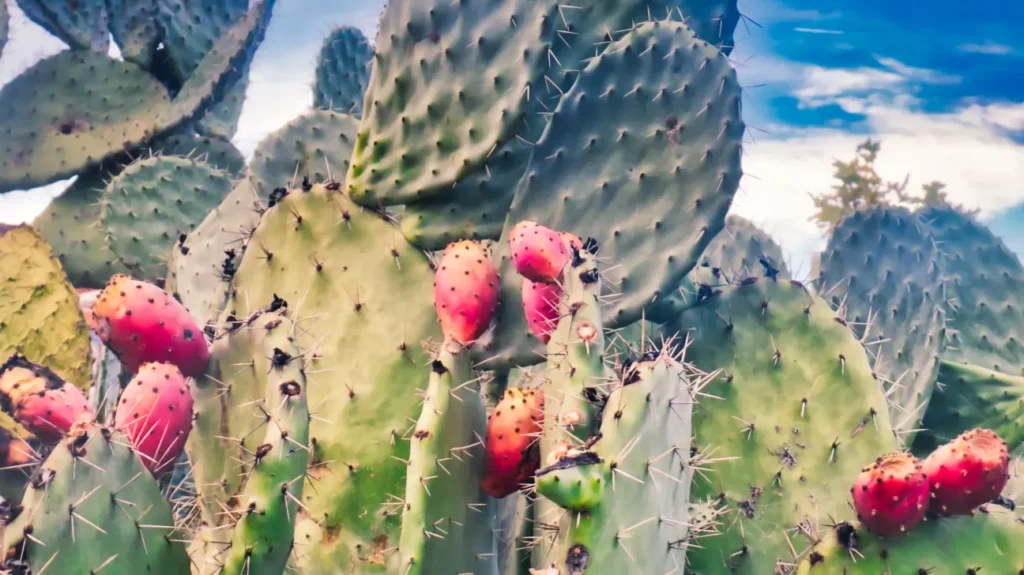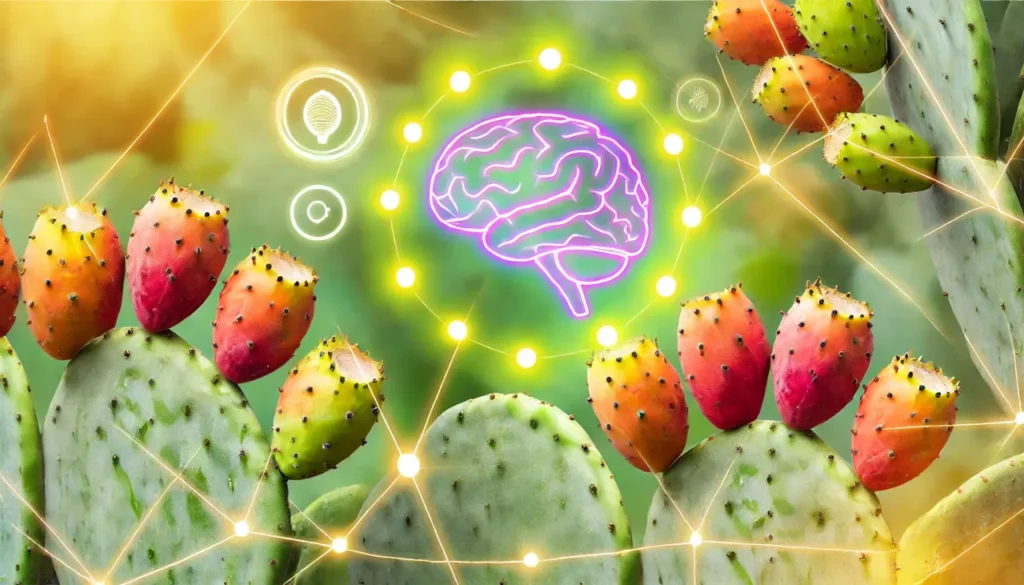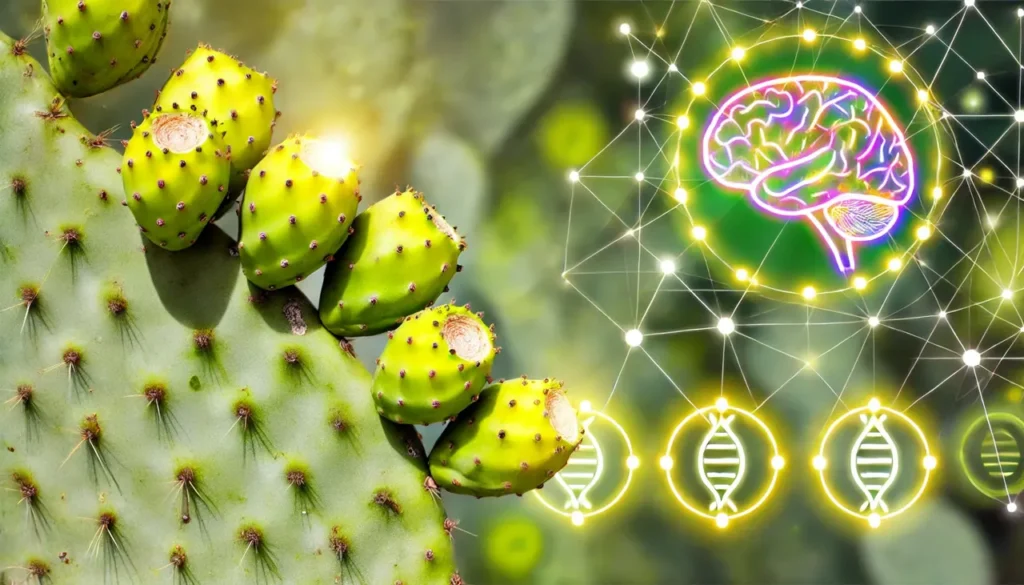Prickly pear cactus (Opuntia ficus-indica), also known as the nopal or cactus pear, is a succulent plant native to the Americas. It has gained significant attention not only for its culinary applications but also for its potential health benefits, particularly its cognitive-enhancing properties, which categorize it as a nootropic supplement. In this article, we delve into the intricate details surrounding prickly pear cactus, exploring its sources, chemistry, physiological mechanisms, potential nootropic benefits, appropriate dosing guidelines, side effects, interactions, and essential considerations for safe supplementation.
You May Also Like:
Sources of Prickly Pear Cactus
Prickly pear cactus is widely consumed in various forms across different cultures, making it both a nutritious food source and a valuable supplement. The primary sources of prickly pear cactus include:
- Fruits: The vibrant fruits, commonly referred to as tunas, are typically purple or yellow and are rich in vitamins, minerals, and antioxidants. They can be consumed raw, juiced, or made into jams and jellies, offering a sweet and tangy flavor.
- Pads: Known as nopales, the young pads of the prickly pear cactus are commonly used in culinary dishes. They can be prepared in various ways, including grilling, boiling, or sautéing, and are often featured in salads, tacos, and traditional Mexican dishes.
- Powdered Supplements: Dried and ground prickly pear cactus is available as a dietary supplement, often encapsulated or included in superfood blends. This concentrated form can provide enhanced nutritional benefits without the need for extensive preparation.
While prickly pear cactus can be enjoyed through various food preparations, supplementation may offer advantages for individuals seeking to harness its cognitive and health benefits in a more concentrated form.

Chemistry of Prickly Pear Cactus
The bioactive compounds present in prickly pear cactus contribute to its health-promoting properties, particularly its potential as a nootropic. The primary chemical constituents include:
- Betalains: These naturally occurring pigments are responsible for the bright colors of prickly pear fruit and possess strong antioxidant properties. Betalains may help reduce oxidative stress, which can be detrimental to brain health, thereby supporting cognitive functions.
- Flavonoids: Flavonoids such as quercetin and kaempferol are abundant in prickly pear cactus. They are known for their neuroprotective effects, helping to maintain cognitive function by combating oxidative stress and inflammation within the brain.
- Phenolic Acids: These compounds have been shown to exhibit antioxidant and anti-inflammatory properties, further supporting the overall health of neural tissues.
- Dietary Fiber: Prickly pear cactus is rich in soluble fiber, which aids in digestive health. This fiber may help regulate blood sugar levels, contributing to stable energy levels throughout the day. Stable blood sugar levels are vital for optimal brain function.
These chemical constituents work synergistically to promote various health benefits, particularly for cognitive enhancement, by improving antioxidant defenses and supporting cellular health in the brain.

Physiological Mechanisms of Prickly Pear Cactus in the Body and Brain
The physiological effects of prickly pear cactus on cognitive function can be attributed to its rich profile of phytochemicals. The key mechanisms through which prickly pear cactus may exert its effects include:
- Antioxidant Activity: Prickly pear cactus is rich in antioxidants, which help neutralize free radicals. The accumulation of free radicals could lead to oxidative stress, a condition associated with cognitive decline and neurodegenerative diseases. By reducing oxidative stress in the brain, prickly pear cactus may play a protective role in preserving cognitive function.
- Anti-inflammatory Effects: Chronic inflammation in the brain has been linked to various cognitive impairments. The anti-inflammatory properties of prickly pear cactus may help reduce inflammation, potentially supporting overall brain health and improving cognitive performance.
- Blood Sugar Regulation: One of the significant advantages of prickly pear cactus is its ability to regulate blood sugar levels. By stabilizing glucose levels, prickly pear cactus could help prevent energy crashes that may impair cognitive performance. This stabilization ensures a consistent energy supply to the brain, which is essential for maintaining focus and mental clarity.
- Neuroprotective Effects: The combined effects of antioxidants and anti-inflammatory compounds in prickly pear cactus contribute to its neuroprotective properties. These effects may help protect neurons from damage, promoting cognitive resilience and reducing the risk of age-related cognitive decline.
Together, these mechanisms suggest that prickly pear cactus may serve as a valuable supplement for enhancing cognitive performance and resilience, particularly in individuals facing stressors that may impact mental function.

Nootropic Benefits of Prickly Pear Cactus
The potential nootropic benefits of prickly pear cactus make it an intriguing supplement for those seeking cognitive enhancement. Key benefits include:
- Enhanced Memory and Learning: The antioxidant and anti-inflammatory properties of prickly pear cactus may support memory formation and retrieval. Research indicates that reducing oxidative stress can improve cognitive functions, including memory, making it beneficial for students, professionals, and individuals looking to enhance their learning capabilities.
- Increased Focus and Attention: By stabilizing blood sugar levels and reducing inflammation, prickly pear cactus may enhance focus and attention span. Users have reported clearer thinking and improved concentration during mentally demanding tasks, contributing to heightened productivity and efficiency.
- Mood Enhancement: The anti-inflammatory effects of prickly pear cactus may also lead to improved mood and reduced symptoms of anxiety and depression. A balanced mood is crucial for cognitive performance, and individuals may find that using prickly pear cactus helps maintain emotional stability, further enhancing cognitive function.
- Cognitive Resilience: The neuroprotective properties of prickly pear cactus may bolster the brain’s ability to cope with stress and recover from cognitive fatigue. This resilience is vital for maintaining cognitive performance during high-pressure situations, such as exams or work deadlines.
- Overall Brain Health: Regular consumption of prickly pear cactus may contribute to overall brain health, supporting cognitive function as one ages. Its rich antioxidant profile helps protect against oxidative stress, while its anti-inflammatory properties promote a healthy environment for brain cells.
These potential nootropic benefits collectively contribute to making prickly pear cactus a valuable supplement for individuals seeking to optimize their cognitive performance and overall brain health.

Dosage and Supplementation Guidelines
When considering supplementation with prickly pear cactus, it is essential to follow appropriate dosing guidelines to ensure safety and efficacy. While there is no established recommended daily allowance (RDA) for prickly pear cactus, common dosages for supplementation based on the form of the product include:
- Dried Powder: The typical dosage for dried prickly pear cactus powder ranges from 1 to 5 grams per day. Starting at a lower dose and gradually increasing it could help individuals assess their tolerance to the supplement.
- Capsules or Tablets: For encapsulated forms of prickly pear cactus, it is crucial to follow the manufacturer’s guidelines. Standard dosages often suggest ranges from 500 mg to 2,000 mg per day, depending on the concentration of the extract.
- Juice or Extracts: When consuming prickly pear cactus juice, it is advisable to aim for about 1 cup (240 mL) daily. However, individuals should be cautious of the sugar content in commercially prepared juices, as excessive sugar intake may counteract the health benefits of the cactus.
As with any dietary supplement, it is advisable to consult with a healthcare provider before starting prickly pear cactus, particularly for individuals with underlying health conditions or those taking medications that may interact with the supplement.

Side Effects and Safety
Prickly pear cactus is generally regarded as safe for most individuals when consumed in moderation. However, some potential side effects may occur, including:
- Digestive Upset: The high fiber content of prickly pear cactus may lead to gastrointestinal discomfort, such as bloating, diarrhea, or constipation, particularly in sensitive individuals. Gradually introducing the supplement into the diet could help minimize these effects.
- Allergic Reactions: Some individuals may experience allergic reactions to prickly pear cactus, resulting in symptoms such as itching, rash, or gastrointestinal distress. Those with known allergies to cacti or related plants should exercise caution when trying prickly pear cactus.
- Interference with Blood Sugar Levels: While prickly pear cactus could help regulate blood sugar, it may also lead to hypoglycemia (low blood sugar) in individuals taking diabetes medications. Monitoring blood sugar levels closely is crucial for those on such medications.
- Potential Kidney Effects: Individuals with kidney issues should consult a healthcare provider before consuming prickly pear cactus due to its potassium content, which may affect potassium levels in the body.
Interactions with Other Supplements and Medications
Understanding potential interactions between prickly pear cactus and other supplements or medications is essential for safe use. Key interactions to consider include:
- Blood Sugar Medications: Prickly pear cactus may enhance the effects of diabetes medications, leading to excessively low blood sugar levels. Individuals taking medications such as insulin or oral hypoglycemics should monitor their blood sugar closely and consult a healthcare provider before starting prickly pear cactus supplementation.
- Blood Thinners: The anti-inflammatory properties of prickly pear cactus may interact with blood-thinning medications, thus increasing the risk of bleeding. Individuals on anticoagulant therapy should seek medical advice before adding prickly pear cactus to their regimen.
- Nootropics and Cognitive Enhancers: Prickly pear cactus can complement other nootropic supplements, potentially enhancing cognitive effects without causing overstimulation. However, individual responses may vary, and it is advisable to monitor personal reactions when combining supplements.
Risks for Individuals with Certain Health Conditions
Certain health conditions may warrant caution when using prickly pear cactus. Individuals with the following conditions should consult a healthcare provider before supplementation:
- Diabetes: Due to its blood sugar-regulating effects, individuals with diabetes should be cautious when incorporating prickly pear cactus into their diets, especially if they are on medication.
- Kidney Disorders: Given its potassium content, those with kidney issues should seek medical advice to prevent any adverse effects on potassium levels.
- Allergies to Cacti or Related Plants: Individuals with known allergies should avoid prickly pear cactus to prevent allergic reactions.
- Pregnancy and Breastfeeding: The safety of prickly pear cactus during pregnancy and breastfeeding has not been well studied. Therefore, it is advisable to err on the side of caution and avoid supplementation during these periods.

Prickly Pear Cactus as a Cognitive Enhancer
Prickly pear cactus emerges as a promising nootropic supplement, offering a range of potential cognitive benefits rooted in its rich bioactive compound profile. By enhancing memory, focus, and overall brain health, it holds promise for individuals seeking to optimize their cognitive performance. However, as with any supplement, individuals should exercise caution, especially if they have existing health conditions or are taking medications. Consulting with a healthcare provider is recommended to ensure the safe and effective use of prickly pear cactus as a nootropic supplement. With its vibrant history in traditional medicine and culinary applications, prickly pear cactus continues to capture the attention of health enthusiasts and researchers alike, paving the way for further exploration of its cognitive-enhancing properties.

References:
- Health Benefits of Prickly Pear. Retrieved from: https://www.health.com/prickly-pear-benefits-7642893
- What are the health benefits of nopal cactus? Retrieved from: https://www.medicalnewstoday.com/articles/320293#
- Chapter 23 – Nutritional and Therapeutic Applications of Prickly Pear Cacti. Retrieved from: https://www.sciencedirect.com/science/article/abs/pii/B9780128138229000230
- Effects of the Consumption of Prickly Pear Cacti (Opuntia spp.) and its Products on Blood Glucose Levels and Insulin: A Systematic Review. Retrieved from: https://www.mdpi.com/1648-9144/55/5/138
Important Note: The information contained in this article is for general informational purposes only, and should not be construed as health or medical advice, nor is it intended to diagnose, prevent, treat, or cure any disease or health condition. Before embarking on any diet, fitness regimen, or program of nutritional supplementation, it is advisable to consult your healthcare professional in order to determine its safety and probable efficacy in terms of your individual state of health.
Regarding Nutritional Supplements Or Other Non-Prescription Health Products: If any nutritional supplements or other non-prescription health products are mentioned in the foregoing article, any claims or statements made about them have not been evaluated by the U.S. Food and Drug Administration, and such nutritional supplements or other health products are not intended to diagnose, treat, cure, or prevent any disease.


